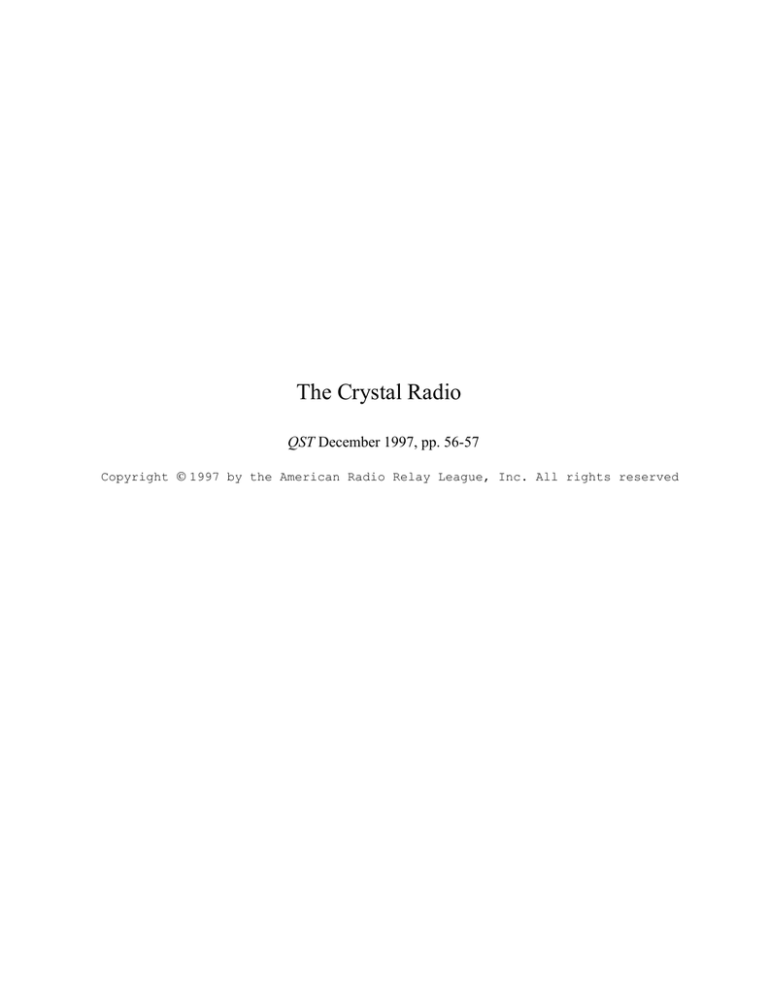
The Crystal Radio
QST December 1997, pp. 56-57
Copyright 1997 by the American Radio Relay League, Inc. All rights reserved
By Dave Evison, W7DE
The Crystal Radio
What’s old is new again!
ven a casual auditor of the amateur bands will conclude that the hobby is largely populated by wizened
old geezers—and I’m one of them. This is a sad situation because most of us entered Amateur Radio as kids.
If ham radio is to continue for generations to come, we must get
youngsters interested in radio communication while they’re still
in grammar school and still capable of wonder. We need to reach
them while they are still asking questions about everyday matters
(that all too often go unanswered) such as, “Why does it get light
in here when I push this thing?”
Reaching today’s kids won’t be easy. With the Internet, cellular telephones and other forms of global communication commonplace in their lives, the true magic of radio lies buried beneath the
technology. We must strip away layers upon layers of complicated
hardware and reveal radio in its purest form. The perfect tool to
achieve this goal is the “lowly” crystal receiver.
Imagine the curiosity you’ll inspire when you demonstrate a
radio that has no obvious power source whatsoever! The simple
crystal receiver described in this article works surprisingly well.
It’s selective and produces robust headphone volume. I’ve been
able to tune several local AM broadcast stations with ease. Best of
all, it’s inexpensive, uses readily available parts, and can be built
by a youngster (with a little guidance). Of course, adults will love
this little receiver, too.
There is a fascinating resurgence of interest in crystal radios.
Even hams normally accustomed to owning rigs with four-digit
price tags are rediscovering the joys of simple, “powerless” reception. To get a taste of what is going on, pick up a copy of Crystal
Set Projects from the Xtal Set Society, Box 3026, St Louis, MO
63130; tel 314-725-1172, or visit their Web site at http://
www.midnightscience.com. (The book was reviewed in the
August, 1997 QST, page 102.)
E
About the Circuit
The circuit shown in Figure 1 was developed in the early ’30s
by Elmer G. Osterhoudt. Selectivity problems plagued most crystal sets of the day due to the proliferation of broadcast stations.
Elmer devised a solution. He determined that poor crystal receiver
selectivity was caused by the headphones swamping the tuned
circuit and lowering its Q. The net result was an inability to separate individual signals. Elmer improved selectivity considerably
by connecting the detector near the cold (ground) end of the tuned
circuit to minimize the swamping.
Capacitor C2 is used to match the antenna system, and C3 is the
main tuning capacitor. Absent from this circuit is the finicky galena-and-catwisker detector. It has been supplanted by a 1N34
germanium diode that is connected near the grounded end of the
tuned circuit that includes coil L1. C1 is an RF bypass capacitor.
Headphones
You must use high-impedance headphones (2000 Ω or greater)
with crystal receivers. If you attempt to use common 8-Ω headphones, you’ll have very disappointing results. You’ll find highimpedance headphones at hamfest flea markets, but if you’re not
56
December 1997
Figure 1—Schematic
diagram of the crystal
receiver. Parts are
available from Radio
Shack or Antique
Electronic Supply
(6221 South Maple
Ave, Tempe, AZ 85283;
tel 602-820-5411) as
noted.
C1—1000 pF mica or disc ceramic trimmer (Radio Shack
272-123)
C2—40 to 500 pF trimmer capacitor (Antique Electronic
Supply CV-263)
C3—365 pF variable capacitor (Antique Electronic Supply
CV-231)
D1—1N34 germanium diode (Radio Shack 276-1123)
J1—1 /4 -inch, 2-conductor headphone jack (Radio Shack
274-252)
L1—35 feet of 22-gauge enamel wire. See text. (Radio Shack
278-1345)
Fahnestock clips (Antique Electronic Supply SH-11-4034)
2000-Ω headphones (Antique Electronic Supply PA-466)
up to the hunt, you can buy them from Antique Electronic Supply
(see Figure 1).
The Importance of a Good Antenna System
Since the crystal receiver depends completely on the energy
from the transmitted signal, you need to gather as much signal out
of the air as possible! Remember that this receiver is designed to
tune the AM broadcast band. A half-wavelength dipole cut for
about 1 MHz would be ideal, but few of us own enough real estate
to accommodate a 500-foot long antenna. The practical solution is
Plastic electrical outlet boxes make terrific enclosures. Note
that I’ve mounted the main tuning capacitor, C3, and the
headphone jack on the front using copper-clad PC board.
to simply use an end-fed wire about 100 feet in length. You’ll also
need to provide a connection to an Earth ground (a cold-water pipe
may suffice). With the proper antenna system, you should be able
to receive most of the AM stations in your area. If you live in a
rural location without an AM broadcaster nearby (within about
50 miles), try using even more antenna wire. Just string it over
trees, bushes, or any other supports.
The rear view of the crystal radio enclosure. You can easily
see the windings of coil L1 held in place with transparent
tape.
You can build a crystal receiver into almost anything. I used
plastic electrical outlet boxes. They’re available at home centers
and hardware stores. They are attractive, rugged and inexpensive.
They even serve as forms for winding the coil. I made the front
panel of my box from a piece of copper-clad PC board. You can
cut this material into the proper shape using a hacksaw, and it is
easily drilled for mounting parts.
For C3, a miniature variable capacitor salvaged from an old
AM-only radio will work, but a single-section air variable is better. If you don’t have these capacitors in your junk box, don’t
despair. You can order one from Antique Electronic Supply.
L1 is wound on the outside rear portion of the enclosure and
consists of 32 turns of 22-gauge enamel-covered wire. The coil is
tapped nine turns from the grounded end. The tap is made by
tightly twisting about 1 inch of the magnet wire and scraping off
the enamel insulation. You can secure the windings to the enclosure with transparent plastic tape.
The antenna trimmer capacitor (C1) and the Fahnestock clips
for the antenna and ground connections are mounted on the rear of
the enclosure. The tuning capacitor, phone jack and detector are
mounted on the front panel. Interconnecting wires are fed through
holes in the enclosure and soldered to the trimmer capacitor,
ground and cold connections.
Inductance: Applying the “right hand rule,” the coil for the
tuned circuit can be used to explain how a magnetic field is developed by electron flow through a conductor, and how the magnetic
field is increased by forming the conductor into a coil.
Capacitance: Varying capacitance may be illustrated by simply observing how the total area increases as the rotor plates mesh
with the stator plates. The compression trimmer capacitor (C1)
illustrates the function of a dielectric other than air. It also shows
how the capacitance can be varied by changing the separation
between the plates.
Resonance, modulation and detection: You can teach these
concepts by inviting your student to tune in a station while you
display the modulated RF on an oscilloscope! Move the ’scope
probe from one side of diode D1 to the other to illustrate “before”
and “after.”
Magnetism and transduction: High-impedance headphones are
ideal instructional aids to demonstrate these ideas. Disassemble a
pair of headphones and show your students what’s inside. Touch
the permanent magnet with a screwdriver so they can see that it is
indeed magnetic. Explain how the detected signal flows through
the tiny headphone coil, creating a magnetic field that adds or
subtracts from the field produced by the permanent magnet. This
causes the metal diaphragm to vibrate, creating sound! What
began as electrical energy has become mechanical energy—
transduction.
Operating Adjustments
Summary
Connect the antenna, ground and headphones. Tighten the
antenna trimmer capacitor C2. Slowly adjust C3 to tune in the
stations. Note the number of stations and log their call letters and
frequencies. Readjust C1 to provide the best trade-off between
volume and selectivity. If you’re using your crystal radio near a
particularly strong broadcast station, removing the ground connections will often improve selectivity (with some reduction in
volume).
Throughout the years, the simple crystal radio has spawned
tens of thousands of radio amateurs, engineers and electronic
hobbyists. And despite the antiquity of its design, it is still an
effective tool for recruitment and instruction. A crystal radio is a
delightful device, and the perfect way to introduce the wonder of
radio to a young mind—or rekindle it in your own!
Construction
Use Your Radio as a Teaching Tool!
You can use your crystal radio to teach a number of important
concepts. For example:
153 Park Ave
Palo Alto, CA 94306
e-mail w7de@aol.com
December 1997
57

